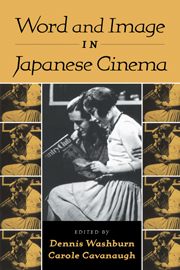Book contents
- Frontmatter
- Contents
- List of Illustrations
- Contributors
- Foreword: Outside Views of the Japanese Film
- Introduction
- PART ONE WORDING THE IMAGE/IMAGING THE WORD
- PART TWO REFLECTIONS OF IDENTITY
- 7 Where's Mama? The Sobbing Yakuza of Hasegawa Shin
- 8 Saving the Children: Films by the Most “Casual” of Directors, Shimizu Hiroshi
- 9 Ishihara Yûjirô: Youth, Celebrity, and the Male Body in late-1950s Japan
- 10 Otoko wa tsurai yo: Nostalgia or Parodic Realism?
- 11 A Working Ideology for Hiroshima: Imamura Shôhei's Black Rain
- PART THREE OUTSIDE THE FRAME OF CULTURE
- Selected Bibliography of Articles and Books in English
- Index
8 - Saving the Children: Films by the Most “Casual” of Directors, Shimizu Hiroshi
Published online by Cambridge University Press: 01 March 2010
- Frontmatter
- Contents
- List of Illustrations
- Contributors
- Foreword: Outside Views of the Japanese Film
- Introduction
- PART ONE WORDING THE IMAGE/IMAGING THE WORD
- PART TWO REFLECTIONS OF IDENTITY
- 7 Where's Mama? The Sobbing Yakuza of Hasegawa Shin
- 8 Saving the Children: Films by the Most “Casual” of Directors, Shimizu Hiroshi
- 9 Ishihara Yûjirô: Youth, Celebrity, and the Male Body in late-1950s Japan
- 10 Otoko wa tsurai yo: Nostalgia or Parodic Realism?
- 11 A Working Ideology for Hiroshima: Imamura Shôhei's Black Rain
- PART THREE OUTSIDE THE FRAME OF CULTURE
- Selected Bibliography of Articles and Books in English
- Index
Summary
Shimizu Hiroshi (1903–66) is something of a forgotten veteran among directors of Japanese cinema. He made over 160 films in a career spanning thirty-four years. Yet he is rarely studied in Japan or abroad. Even the best of his films seem neglected, even by the Japanese.
Oddly enough, Shimizu's most significant contribution to the Japanese film history lies in a genre his country's cinema is famous for: films about children. It could be argued that posthumous neglect is the price he pays for having been a notably casual craftsman. His ruling passion, both in art and in life, had more to do with a kind of philanthropy. As we shall see, Shimizu aimed to do this weary old world some good by showing how children can be rescued, and maybe grown-ups, too.
How did he come to this? Why should he have become increasingly involved in the fate of children on screen and in real life beginning in the mid-1930s? What qualities made him a master of such films? In order to address these questions, we must first get him in perspective.
It could be that Shimizu's reputation suffers from a surfeit of good company in the Golden Age of Japanese cinema of the 1930s, including the versatile Ozu Yasujirō and Shimazu Yasujirō. These two we know as specialists in the shomingeki genre the drama of middle-class family life.
- Type
- Chapter
- Information
- Word and Image in Japanese Cinema , pp. 174 - 201Publisher: Cambridge University PressPrint publication year: 2000



